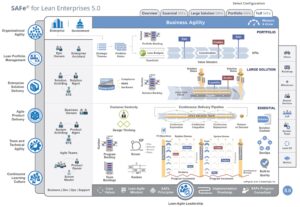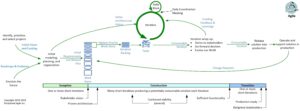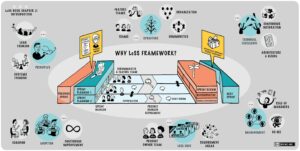Recognizing changes in the corporate environment and reacting to them promptly by adapting the individual components of the business model, such as the value proposition, resources or processes, to the new circumstances – that is the basic idea of agility. However, many companies have yet to build the capabilities required for this. For a company that traditionally works with classic project management methods, even a small-scale changeover can be a challenge for individual teams. It becomes much more difficult when the business environment requires the organization-wide introduction of agile methods. Not least because the first agile methods, such as Scrum, do not even address collaboration across different agile teams. In order to be able to use agile methods across the entire company, several so-called agile scaling frameworks have been developed since then, which enable exactly this cross-team collaboration.
Prominent examples of agile scaling frameworks are SAFe, LeSS, Nexus, Crystal or DAD. SAFe is the most widely used framework internationally (29 % of users of agile scaling frameworks), followed by internally developed methods (10 %). LeSS and DAD share the third place (5 % each).
SAFe – Scaled Agile Framework
The Scaled Agile Framework combines various agile methods, such as Scrum, DevOps, Kanban and XP, with the world of thought of Lean Management. SAFe has various configurations, ranging from the combination of individual teams in an Agile Release Train (in the so-called “Essential SAFe”) to overall corporate management in the form of agile methods in the so-called “Full SAFe” configuration. Here, the process organization is modeled from the overall strategy and portfolio view to the development of solutions at team level using structures, processes and techniques, roles, activities and tools. SAFe exhibits a relatively high degree of formalization in this respect. Core artifacts in SAFe are the so-called Agile Release Train and the Solution Trains. The Agile Release Train is a relatively stable unit consisting of several agile teams and typically has 50-125 members. These are organized around “value streams” that are significant for the organization and are aimed at creating solutions that generate value for the user as a whole. The Solution Train, in turn, is the organizational construct in which large and complex solutions are created, which requires the coordination of several Agile Release Trains. Several hundred or even thousand people are organized in a Solution Train.
DAD – Disciplined Agile Delivery
The main focus of DAD is on the correct application of different agile and classical methods depending on a specific situation. DAD is a hybrid approach that extends Scrum with proven strategies from Agile Modeling (AM), Extreme Programming (XP), Unified Process (UP), Kanban, Lean Software Development and various other methods. DAD also looks at the overall organizational level and aims to create agility at different levels of the organization. The challenge that DAD aims to meet is the often undisciplined use of agile methods – DAD therefore strives for a disciplined and structured way of using agile methods. Basically, DAD assumes that most teams are not helped by a complete, detailed planning of the processes. Contrary to SAFe’s formalized framework, a framework is therefore propagated that has a certain degree of flexibility in order to be adapted to the respective company situation. DAD shows approaches for the disciplined use of agile methods in many ways.
LeSS – Large Scale Scrum
Another representative of agile scaling frameworks, which enjoys a high degree of popularity, is the LeSS framework. In contrast to SAFe, LeSS is characterized by its explicitly unformalized, i.e. more principle-based nature. The motto of this method is therefore also “LeSS is more”, which is a reference to the core idea of the method. The authors allude to the relevance of self-organization in the team, which is necessary for building agile skills. The LeSS method therefore also focuses very strongly on the cultural aspect of scaling agile structures in organizations. Based on the Scrum method, only a few roles, activities and techniques were introduced in the LeSS framework, but all of them are based on the Scrum method.
Conclusion
A comparison of the various agile scaling frameworks reveals significant differences. SAFe is highly formalized and describes the solution creation process in great detail. Therefore, it offers, apart from the individual configurations, rather little room for adaptation to the needs of an organization. In addition, SAFe is very strongly focused on the supply organization and does not describe how ideas can be generated and transferred into the delivery process of solution implementation. DAD shows a hybrid approach with several agile methods and is less formalized than SAFe. DAD takes a holistic view of the company and considers the entire lifecycle of solutions from idea to termination. However, DAD only shows in a very undetailed way how the process of an organization acting according to DAD principles can look like. LeSS is the framework that focuses most on principles and culture. LeSS provides almost no descriptions of how the solution creation should be organized.
Against this background, it is advisable to consider the agile scaling frameworks only as reference models that should be adapted to the corresponding situation in the company.
Links
- Full articles from Daniel Proba in german (Part 1 & Part 2)
- SAFe – Scaled Agile Framework
- DAD – Disciplined Agile Delivery
- LeSS – Large Scale Scrum


